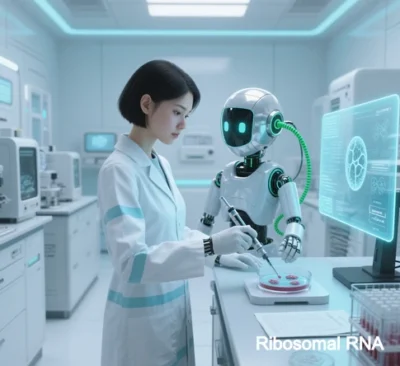
Ribosomal RNA (rRNA): Multidimensional Insights Revolutionizing Life Sciences
From Reconstructing the Tree of Life to Precision Medicine
I. Evolution and Taxonomy: Rewriting the Foundations of Life
- The Three-Domain System: Comparative analysis of 16S/18S rRNA sequences revealed the Bacteria, Archaea, and Eukarya domains, while exposing that >99% of microbial diversity remains unculturable. This spurred research into “unculturable microbiomes,” such as deep-sea hydrothermal vents and the human gut.
- Evolutionary Plasticity: Eukaryotic rRNA expansion segments (ESs), like the 670-nt-long ES27L in human 28S rRNA, undergo conformational shifts (e.g., 27L_in vs. 27L_out) to recruit translation regulators, potentially driving eukaryotic complexity.
- Metagenomics Revolution: Optimized 16S rRNA primers enhance microbial diversity analysis by 40%, covering 99.3% of known bacterial phyla. Databases like SILVA and RDP-II integrate >5 million rRNA sequences, enabling ecosystem-level studies from polar ice to tumor microenvironments.
II. Structural and Functional Dynamics: The Molecular Ballet of Translation
- Atomic-Level Ribosome Mechanics:
- Cryo-EM shows Mycobacterium tuberculosis 23S rRNA mutations (e.g., A2451) alter the peptidyl transferase center (PTC), reducing antibiotic (e.g., valnemulin) binding affinity 100-fold.
- Eukaryotic 18S rRNA helix 44 ensures tRNA selection fidelity (<10⁻⁴ error rate), mediated by ESs and translation factors.
- Epigenetic rRNA Modifications: Bacterial rRNA methylation (e.g., TrmD-catalyzed m¹G37) adapts translation to stress. In MRSA, disrupting methyltransferases restores β-lactam sensitivity.
- Ribosome Heterogeneity: Specialized ribosomes with distinct ESs selectively translate mRNAs to regulate stem cell differentiation and cancer metastasis. ES39L loss in mouse embryonic stem cells reduces pluripotency gene translation by 70%.
III. Cross-Disciplinary Applications: From Mechanisms to Engineering
- Synthetic Ribosomes:
- Orthogonal translation systems replace E. coli 16S rRNA anti-Shine-Dalgarno sequences to isolate toxic protein expression.
- Engineered 23S rRNA PTC incorporates non-canonical amino acids (e.g., pyrrolysine), expanding synthetic biology toolkits.
- Nanoscale rRNA Sensors: Fluorescent probes targeting M. tuberculosis 16S rRNA detect single cells in sputum with 1,000x higher sensitivity than PCR.
- Origins of Life: The rRNA catalytic core (e.g., PTC) retains RNA World features, supporting hypotheses that primordial ribosomes formed peptides without proteins.
IV. Technological Innovations: Sequencing to AI-Driven Design
- Single-Cell rRNA Sequencing: Microfluidic chips with MDA capture full 16S-23S-5S rRNA operons in individual bacteria, revealing strain-level heterogeneity.
- Spatial Transcriptomics: rRNA in situ hybridization maps microbial spatial distributions in tissues, elucidating tumor-microbiome interactions.
- AI-Optimized Design:
- Deep learning (e.g., AlphaFold-RNA) predicts rRNA-protein interfaces, guiding antibiotics like ES27L-targeting antifungals with 8x higher affinity.
- Generative Adversarial Networks (GANs) simulate rRNA evolution to engineer heat-resistant archaeal ribosomes.
V. Clinical and Biotech Translation: Diagnostics to Therapies
- Precision Diagnostics:
- 16S rRNA RT-qPCR distinguishes M. tuberculosis in 2 hours (1 CFU/mL sensitivity).
- 18S rRNA 2′-O-methylation profiles in circulating tumor cells predict breast cancer metastasis (AUC 0.93).
- Novel Therapies:
- PTC-inspired inhibitors (e.g., LFF571) target C. difficile (MIC₉₀ 0.25 µg/mL) without mitochondrial toxicity.
- AAV-delivered mitochondrial 12S rRNA repairs reverse hereditary hearing loss.
- Antiviral Strategies: SARS-CoV-2 hijacks host 28S rRNA ES27L; inhibitors like RK-33 reduce viral load by 99.7%.
VI. Future Directions: Challenges and Opportunities
- Challenges:
- Cryo-EM resolution limits (~2 Å) hinder millisecond-scale translation dynamics capture.
- Standardizing global rRNA databases requires unified metadata formats.
- Opportunities:
- Quantum simulations model 23S rRNA vibrations to design antibiotics leveraging quantum tunneling.
- Synthetic rRNA genomes with engineered ESs enable programmable “smart translation” for on-demand biopharma production.
Conclusion
rRNA is not merely a translation machine component but a master key unlocking life’s multidimensional mysteries. From reshaping evolutionary trees to decoding diseases, and from environmental ecosystems to synthetic biology, rRNA research drives paradigm shifts. With single-molecule technologies, AI, and synthetic biology converging, we approach an era of “programmable ribosomes,” where the rules of life’s translation machinery will be rewritten.
Data sourced from publicly available references. For inquiries, contact: chuanchuan810@gmail.com.




